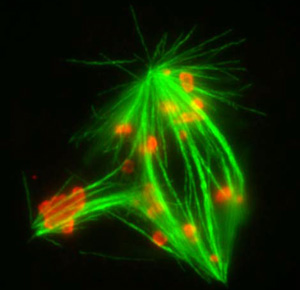|
From rxpgnews.com Cytology
The rod-shaped filaments of the microtubules are responsible for dividing the chromosomes in a cell. They form a connection between the starting point in the chromosomes, the kinetochors, and the centrosome. The centrosome organizes the spindle-shaped arrangement of the microtubule filaments in the cell by means of gamma tubulin ring complexes. Until now it was assumed that control of even distribution of chromosomes was only monitored by the checkpoint kinases in the kinetochors. When microtubules are correctly attached to the kinetochors, these kinases then inform the cell that a precise distribution of chromosomes can be carried out.
Another surprising finding is that these control mechanisms function independently of the integrity of the kinetochors or the centrosomes. This reveals that a cell has widely differing mechanisms for controlling cell division and monitors these directly at the level of protein complexes. These findings are extremely important for the understanding of cell division regulation, which is often disrupted in cancer cells. The checkpoint kinases in cancer cells are frequently modified or present in incorrect quantity ratios. In their next step, the researchers plan to carry out targeted analysis of the molecular reactions between the different regulatory proteins and then investigate how these interactions differ in healthy cells and cancer cells. Long term, this could lead to the development of new diagnostic or therapeutic strategies. All rights reserved by www.rxpgnews.com |
